This November, I again made a trip to Milan, to understand:
- Why does a guy (Gian) who has had many AudioNote/Kondo (M7, M10, Gakuon, 2 ongakus, Neiro Silver, Kageki, Baransu, and 2 Sougas, and an entire Audio tekne set up move to CH Precision after comparing it with biamped Sougas?
- What would happen to the Wilson Alexandria system I heard with top Viva preamps and power amps that has now been replaced by CH?
- How would the new Torqueo fare against the mighty Vyger? This was to be my 5th system where I would not only get to listen to the Vyger, but also compare it to another TT.
- The journey also led me to discovering the AN IO Ltd Japan, the Montagna speakers, and the Riviera amps.
- A SPU shootout between Ortofon SPU A95, A90, A85, Synergy, and Gold reference
- And finally a visit to the Yamamuras again, best system along with Mike’s and to one of the wisest audiophiles.
CH Precision with Wilson Alexandria X2S2
We first started with Marco, whose system I had heard with the top Viva Linea 300b preamp and the 845 30w power amps, phono two years ago. Marco had moved from the Krell Evo 1 to the Viva set up, but after initially comparing the CH preamp with the viva, he bought the CH L1 pre, and then the Phono P1 and the A1 power amp – he had set up an entire CH precision stack including replacing the Vivas. The turntable and cartridge were the same, the Bergmann Sindre with Lyra Atlas.
While I did not have direct back to back compares, I distinctly remember that my previous impression of this system was nice harmonics and decay, but lesser drive. Now, I was hearing a very clean, fast sound, a soundstage that was very transparent in appearance, grain free. Unlike with Spectral which is another quick, clean, extended SS amp, I was getting prodigious but linear midbass. There was no harshness, but in fact the CH was quite pleasant sounding.
We played many records, and I was noticing that on my previous visit I had been more troubled by bass boom than on this occasion. Whether this was due to the valve amps not controlling the woofers properly leading to loose bass in an otherwise live room, I cannot say. But now, the sound and control was cleaner.
On each record, the 4 of us played around with the Dalby record weight that I had brought along. On each record, we found it to have a positive impact by a large degree on weight, bass, decay, tone, and stage.
Riviera and the AN IO Japan Ltd
From Marco’s place, we went over to Carlo’s. This is my third visit to Carlo, having heard his Wilson Grand Slamm X1 with Mark Levinson (ML) 32 pre, ML 33 power followed by upgrading to Riviera AFM 50 hybrid monos of 50w per channel, and now upgrading to the Riviera APL 01 preamp. My previous notes with the ML electronics note the sound as dark, today I had no such issues. He had also added, to his Micro Seiki BL 111 an AN IO Japan Ltd. Which is a field coil cartridge with a battery supply, and due to its 0.01 output was going through the Audio Note S6 SUT and the Uesugi phono with the Ortofon 309 arm.
This was one of the best analog set ups I have heard, certainly the best in terms of price to value, with the caveat that I was unable to compare it to another TT/cart. Today all 4 of us sat transfixed with each LP, unable to take it off. How much of this was due to the cart, I could not say at the moment.
As expected, Gian and his friends had the minute details of all possible variants. Gian said the S6 SUT was almost as good as the S7, but for less price, while the Kondo SUT was a clear step up. The Kondo IO M had been compared by Carlo and the AN IO Ltd Japan was preferred.
During the session, Carlo rolled out the Mullard in the Riveira amp and replaced it with the stock valve, and the magic was lost. Put the Mullard back in, and the magic was back. I agitated over this for days – I was unable to point out exactly what caused the magic here, the AN IO or the Riviera with the Mullard.
I therefore will defer you to some experts – Gian, zerostargeneral, Puresound (guyser on WBF, who was part of the design team on Voyd reference in his college days and has visited Kondo on a training on how to build carts), and Pietro said this was one of their favorite, if not the favorite cart. The cart has a nice tone, body it does nothing to grab your attention in a sudden manner, but just the flow, tone, and timing keeps you focused on the music.
I then arranged a shootout of this cart with Guy on the Brinkmann Balance with FR 66s and the S6, comparing to Etsuro Urushi, Decca London reference, Koetsu Jade with Diamond Cantilever, and various SPUs and FR carts. The person who owns this system lives in London and I have regular access, so carts apart from the Etsuro and the AN IO J Ltd are well settled in his system, and I have compared them over time. I will write in more detail on this system in a separate report, but here we did not find the AN IO J Ltd as impressive. I asked Pietro his thoughts, and he said that the FR 64s might be a better match as it is higher energy, the 66s has more weight and authority and is calmer, which does not suit the cart. Pietro uses it with the Pluto 5a, which he considers an arm bright enough for this cart.
This cart definitely requires careful implementation, and the added leads for the battery cause you to have 6 wires from the tonearm, causing a hassle. Pietro suggested that if you want to avoid the hassle, get the Kondo IO M, which he uses with the Da Vinci 12 inch Great Grandezza reference. His other carts are the top Zyx ultimate diamond, the top Clearaudio goldfinger statement, and the top Allaerts Formula.
Anyway, an extremely musical set up by Carlo there, housing giant speakers in a room that is not very big but is packed with natural furniture and LPs and carpet, a few low priced diffusers and absorbers. The whole analog set up can be bought used from around 10 – 15k.
On his TT, which has a vacuum hold down, the impact of the Dalby was positive but much lower in delta than on the Bergmann Sindre, possibly die to the vacuum hold down.
Riviera (www.rivieralabs.com)
Riviera is a new name, the two partners are Luca Chiomenti that produce top tube amps for the Italians before, and Silvio Delfino www.silviodelfino.com
All products are Hybrid with tube, mosfet and transistor pure class A, zero feedback. Apart from the monos Carlo was using there is a 10w integrated, AIC-10, which is also a headphone amp.
Gian’s System
Moving on to Gian’s system, which I was extremely excited about due to the shootout between the Vyger Atlantis Gen IV, and the Torqueo with the modded SAEC 407 arm supplied by Torqueo.
This was my third visit to Gian.
Before readers go oh, solid state on 98 db, here is some background from Gian, who preferred 2A3s compared to larger tubes:
“I compare Audio tekne Yamato with 211 vs Audiotekne TM 9502 with 6A7Sg, and this was more transparent,natural and faster,then i compared FAL with Ongaku and FAL with 2A3 was much more transparent than Ongaku. My friend had for some years M 1000 MK II and Shinden and Souga, and we tested many times with different cartridges and Souga was more dynamic and fast than Shinden
Gian has the same phono P1 and the linestage L1 as Marco, but with the X1 power supply, and he has the mono amps M1.
I had previously compared the Lyra Atlas SL on the Bergmann Sindre to the Opus, and both Gian and I had found the Opus to be more natural, better stage, and while a bit less macro dynamic, more musical overall.
Now, we started with the Opus on the Vyger, and compared it to the Koetsu Coralstone with Diamond cantilever on the Torqueo. The Vyger was superior on all counts – more weight, greater soundstage, more detail, and more flow. The Vyger is the best along with the American Sound 2000 on the highs – the highs go on forever without actually seemed bright or etched at any point (which I feel TTs like the Avid Acutus do, they draw your attention to the highs at the cost of the body). The Vyger gives a soundstage without, unlike Techdas, forcing a soundstage or forcing the bass. It runs deep, and linear, like the Brinkmann Balance, without seeming fat or thick.
Linear Trackers:
Now, I heard the Bergmann Sindre at Marco’s, the Vyger in many systems including here at Gian’s and the Versa Dynamics later at Pietro’s. As I discussed with Gian here, and later with Pietro and the General, when I hear a linear tracker, I don’t hear an arm, just the sound of the cartridge. It is nimble and airy and nuanced. The Versa Dynamics like the Vyger is also air bearing and vacuum hold down, and has the shortest arm where you can barely see it except for the needle sticking out. On the arms, there is no skating and anti-skating force, so due to less inertia we hear these faster, more dynamic sounds. Other LTs like the Sindre have less weight and authority as compared to pivoted arms mass on high mass tables. Pivots have a nice smooth glide and weight and authority. What the Vyger does brilliantly is, along with the positives of the LTs, it also has weight and authority, and heft. Gone is the lightness issue that plagues LTs, and in comes the airiness and the nuance backed by weight. I will revisit this in the article with the Pnoe and the Vyger and Thomas Mayer and original LPs.
See how small the arm of the Versa is
However – I do think the Opus is a bit thick for the Vyger. We moved to the Atlas SL on the Torqueo, and unlike with the Sindre, the SAEC seemed tailor made for the Atlas SL. I remember J Carr used FR 64s with the Atlas before moving on to SAT. With the SAEC+Atlas SL, the Torqueo exploded in soundstage, speed, and dynamics and details. Personally, I think the Atlas SL will be better suited for the Vyger – at least, when Gian shifts those carts, and mounts his Techdas AF3 premium with the Basis Super 9, I would be interested in a revisit.
Here, the impact of the Dalby on the Vyger, which has both suspension and vacuum hold down, was negative, while on the Torqueo, it was positive. I am finding that these weights work on those TTs best without suspension.
The Montagna speakers
The above are Gian’s Montagnas.
This is he
These are Pietro’s
Regarding the sound of the system: Gian’s room is quite live. He loves to listen to all sorts of music, including jazz, electronics, and rock. His style of sound is hard hitting, clean, extremely fast and extremely loud, requiring high frequencies. I really liked it, but what I was missing was layering behind the speakers and midbass. Now, I already knew that CH was handling midbass very well, as was the Vyger and the Opus, so what was the speaker doing? I found the answer in a visit to Pietro a few weeks later.
Pietro has the Montagna with the Thorens, Da Vinci Great Grandezza reference, Kondo IO M, into a Shindo Monbrison pre with built in phono, into an old Goldmund amp that is available used at 2k. Yes, both Gian and Pietro use SS amps with the 98 db speaker that has a simple first order crossover at 6db. However, Pietro adds some valves into it, and that was my guess what caused the midbass coherency I was wishing for. However, Gian told me that the day before I visited Pietro, the designer had visited Pietro and changed the configuration of the speaker, to allow for more midbass. Hurray, I had won a blind test there. Also, Pietro keeps his speakers 3 feet from the wall, and Gian’s are 3m… possibly leading to the backward layering and wall support that Pietro is getting. Gian is planning to address this after he gets a new rack – currently, his rack is between the wall and the speakers leading to the greater distance.
Gian and Pietro have been friends for twenty years, and I do not know people who are more knowledgeable about audio than these two, and with the least amount of “I have seen everything I am right you are wrong attitude”. Both are extremely open to playing, and take and provide feedback. I have had great learnings from both. The great thing is, they are 99% aligned, and go their own way on 1% – Pietro adding valves, and Gian taking out some top quality valves for his CH. I think a lot of this comes down to choice of music and listening style. Gian himself loves Pietro’s Yamamura, and would love to get a 3 or 4 way horn that no one makes well at a lower price. So he has settled for the Montagna, a speaker that in parts alone costs 15ish K Euro. And his other favorite speakers, are quads and LS3 5a. All these guys love linear trackers. All are into the smallest triodes over 211s and 845s – at least, those are Gian’s second choices after CH. So there are more similarities than differences, but no stubborness on insisting there is only one solution.
Now, at Pietro, as I mentioned, I learned some more things about the Montagna. I realized, like at Gian’s, that this was a speaker with high speed and leading edge attack on violins and piano. I was reminded of listening to the American Sound with the VDH Stradivarius, which is where I got such attacks on the leading edge. It is very nuanced, and open in the mids and the treble. While listening to operatic choruses, I realized that the highs are ever extending with extremely high resolution – in fact, I mentioned to Pietro if I got this speaker, I would listen to more and more opera. Ever since I heard the dynamic choruses of Tchaikovsky’s Eugene Onegin at the Royal Opera House, I wondered what speaker could do this – the Montagna is your answer. The magnets are made in Maxalco and construction includes carbon fibre, you can see details of construction at www.hiend.it
This is like an electrostat with more bass and dynamics – similar transparency and openness and see through, but even quicker and with more resolution. It does have a hybrid woofer like the Logans, just a larger woofer, and is way more sensitive and easy to drive, and with better tone. In fact, I would like to hear this teamed up with the Berning Quadratures, because their highs are also like the CH and the Goldmund with the cleanliness and transparency, but they have a valve decay as well. I understand that another friend of theirs, who had this speaker with Kondo Souga and Gakuoh and was always a Kondo fan, has now moved to an all Goldmund set up in a 15 sq. m. room. I will certainly go to visit him, as I am now excited about exploring the Montagna. On the flip side, compared to panels, it has to be managed to add layering behind. It is quite hard hitting, and would not suit those who prefer a rolled off sound. Pietro has tried various amps with it, from Kondo Souga and Kageki to Shindo and other SETs – he owns the top of the line Shindo single ended WE 300b (which, by the way, is up for sale) with NOS WE 300b valves. He said the Montagna can be driven with it but for his big room he prefers the Goldmund.
SPU Shootout
At Gian’s we had a SPU shootout on the SAEC arm on the Torqueo.
The A95 and A90 were preferred over the A85. The 95 had the most detail, while the 90 seemed a good mix of the detail of the A95 and the flow of the old SPUs. I have done an A95 vs A85 compare on a Schick arm before and found the A95 better by quite a margin. In another shootout I have also liked the first Classic.
Torqueo (http://www.torqueo-audio.it/zebrano-exclusive/)
Gian had initially ordered the Torqueo Marsala but Torqueo was later doing the same TT but one limited edition series with plinth a little bigger, the Pilastro arm base weight 12 kg instead of 7 kg, the deck 11 mm instead of 6 mm, and all made in bronze and copper instead of steel and aluminium, plus other details. The price was 80% higher with more weight and more transparency, so Gian ordered this instead.
Check the difference between Gian’s Pilastro arm base to the normal base – you can have the Torqueo base to house any from 1 – 4 arms.
Pietro’s Visit
And finally, a few weeks later, at Pietro’s.

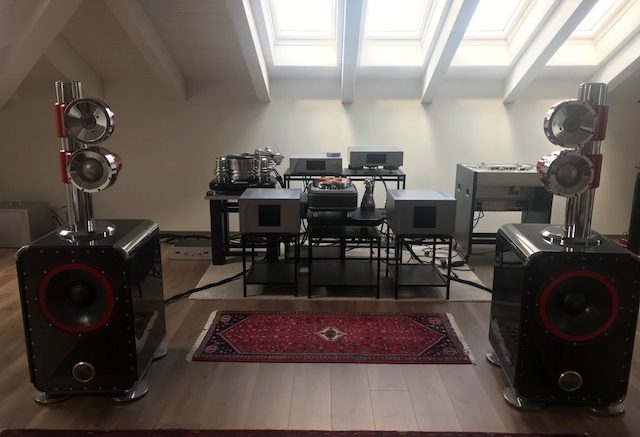



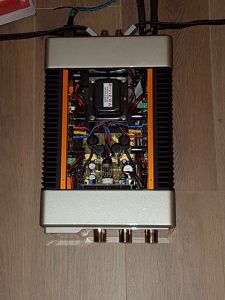
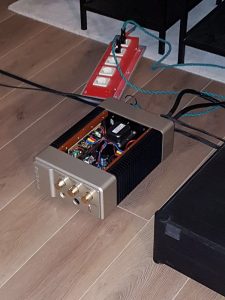

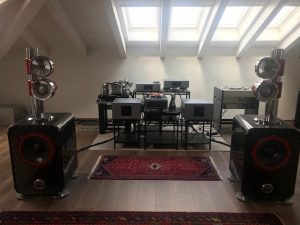
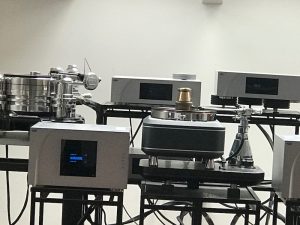
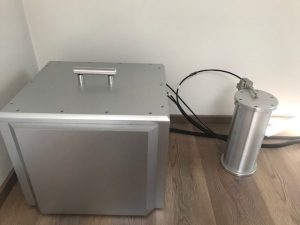
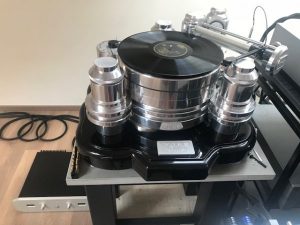
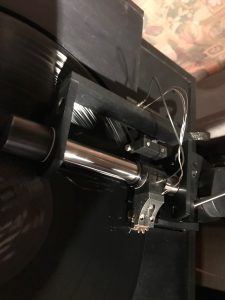


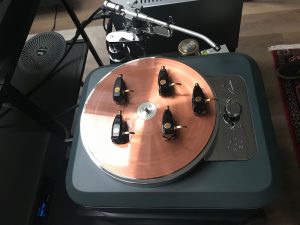
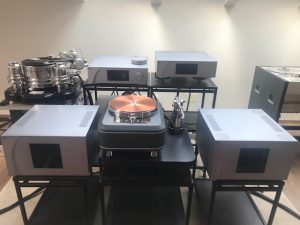
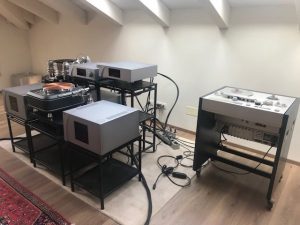
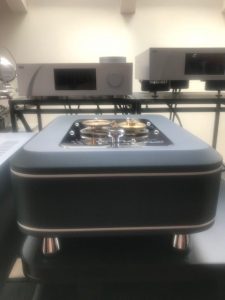
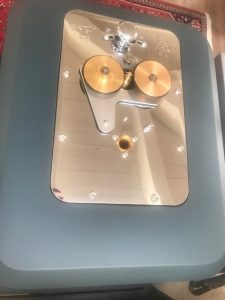

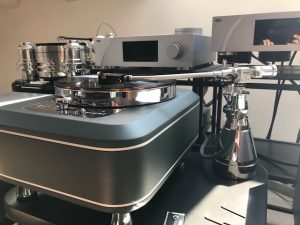

Be the first to comment on "Milan Part II"